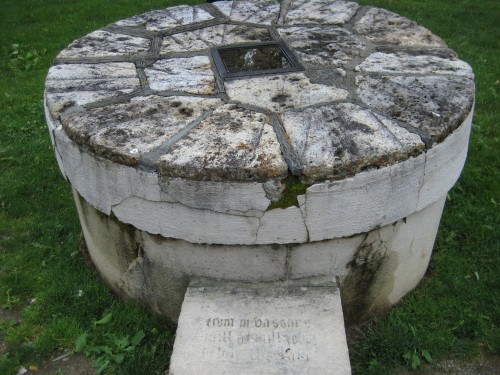
- Panoramic view of Vassar Lake from 1912, with Raymond Avenue on the right
On September 5, 1933, a Poughkeepsie Eagle News article came out under the headline “Dam At Vassar Lake Goes Out.” Heavy rains had put considerable strain on the rotting, wooden structure, causing the gate to give way and the lake to drain dry. Fortunately, the water took its natural course and no damage was done. However, the incident raised concerns about the health of the lake and sparked a debate about whether it should continue to exist. Lack of upkeep seems to have been the main culprit, as explained in the article, which described the architecture of the lake as follows:
“The end of Vassar Lake, which is near Raymond Avenue, is closed by a highway. A culvert runs under the highway and on the opposite side of the road from the lake it is closed by a gate which originally could be raised to drain the lake. The lake has not been drained in 30 to 40 years, however, and the mechanism of the gate has long become impossible to operate.”
A later article, titled “Emptied Vassar Lake Recalls an Earlier and Quieter College,” reflected on the lake’s past as conversations over its future took place at the college. The discovery of a plume 15 by 18 inches in the aftermath of the dam break had provided interesting clues about the lake’s history. The plume, it appears, had been constructed to insure year-round water supply for the former grist mill, which, dating back to the 18th century, was the reason the lake was known as Mill Cove Lake in the early years of the college. In 1933, the mill’s foundations remained “just behind Raymond Avenue, right across from the stream,” and the old millstone decorated the front of Rockefeller Hall. While the foundations are probably impossible to locate now, the millstone continues to stand in front of ‘Rocky.’

- The millstone in front of Rockefeller Hall at Vassar. The engraved writing partly reads “from M. Vassar’s mill at Mill Cove…”
Vassar Lake, the article reported, is man-made, though no record of its origin exists. It is fed by the Fonteynkill, once a pure, healthy stream, which, already in 1933, had been “piped through the city, sent through dumps and swamps and turned into a stream of dirty, foul water which lay stagnant in the lake.” As a result of rechanneling and contamination, the wildlife in the stream and the lake suffered badly. “Trout used to thrive in it but only carp can carry on the battle for life in it now,” the article recalled.
Back at the college, authorities debated whether to build a new floodgate and refill the lake or to allow the site to develop into a meadow through which the Fonteynkill could flow freely. Proponents of the former option argued that the stream did not supply enough water to keep the lake fresh, while defendants of the lake believed that it could be restored to a place of scenic and recreational value. The Poughkeepsie Eagle News reporter seems to have favored restoration of the lake, judging by his decision to conclude the article with the following words:
“Mill Cove Lake looks strange now. It is a mass of wet mud, with tin cans sticking out of it, a puddle here, an island there. There are some carp lying in the mud and others are congested in the big puddle in the center of the lake bottom. The small docks with their iron rings for tying up boats and the steps leading down to the water line look as though they don’t belong there. The walk with its edge of grass reaching down to the black mud looks strangely high and dry. One gets the feeling that something is missing. Yes, the water ought to be there.”
For more information on the history of Vassar Lake, see Vassar Lake Once Popular Among Students
Information from:
“Dam at Vassar Lake Goes Out”, Poughkeepsie Eagle News, September 5, 1933
“Emptied Vassar Lake Recalls an Earlier and Quieter College”, Poughkeepsie Eagle News, September 9, 1933
Photo credits:
“Vassar Lake,” Library of Congress: American Memory, 1912
“Rockefeller Hall at Vassar College,” Wikipedia, http://en.wikipedia.org/wiki/File:Rockefeller_Hall_%28Vassar_College%29.jpg, 2009
“Millstone in front of Rockefeller Hall,” Nadine Souto, 2010